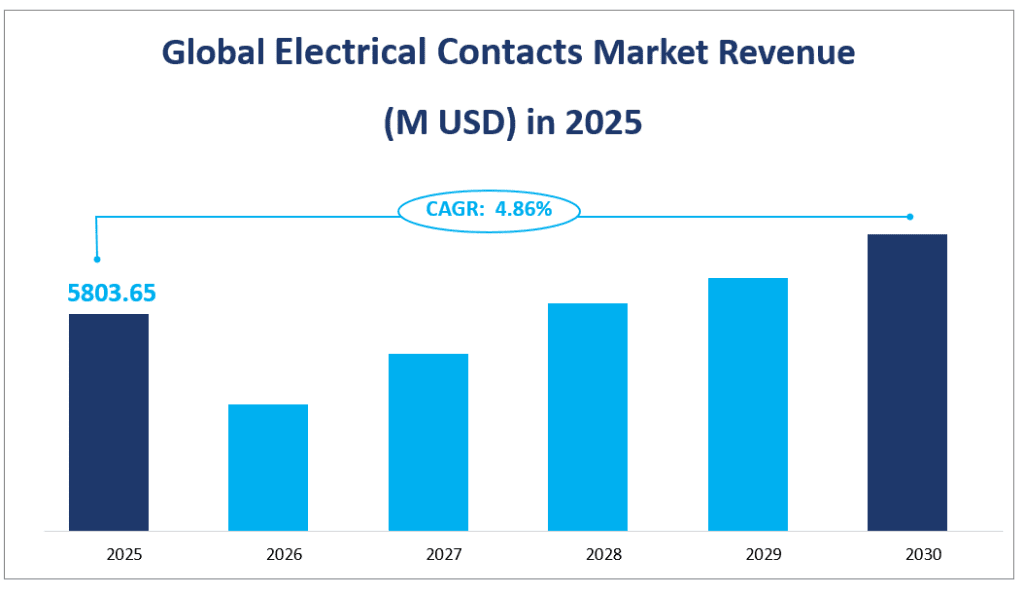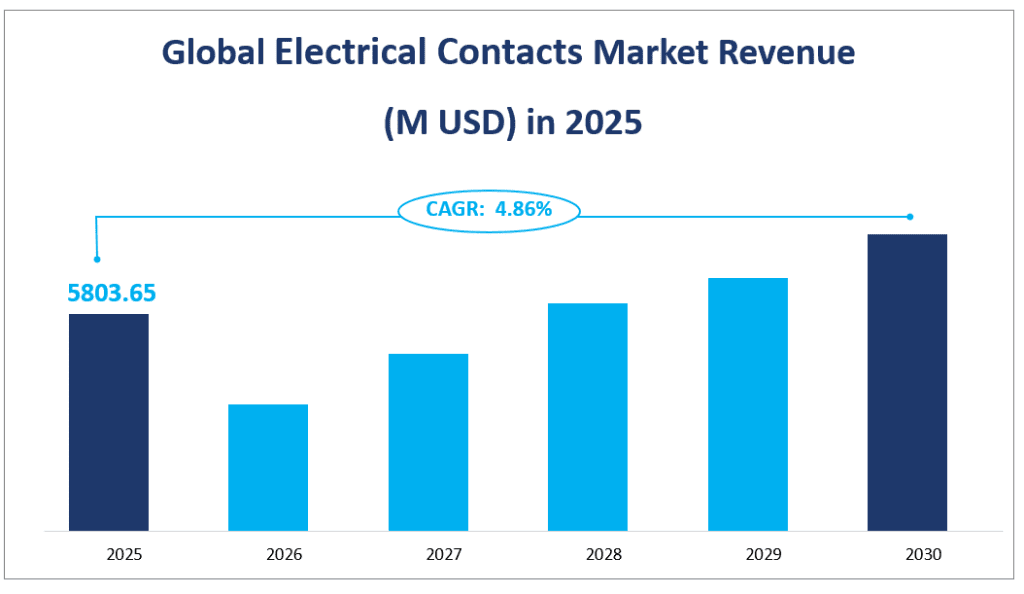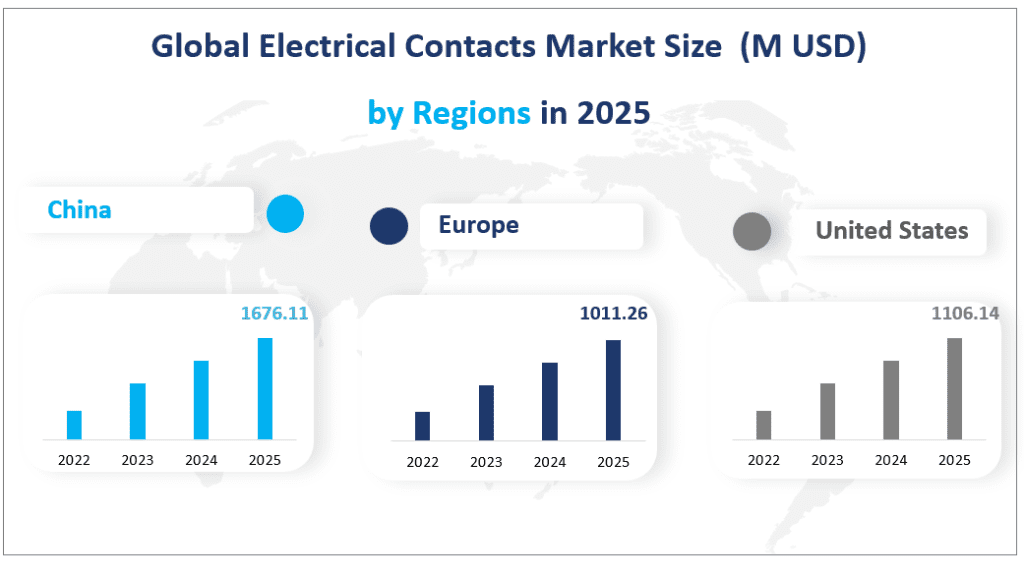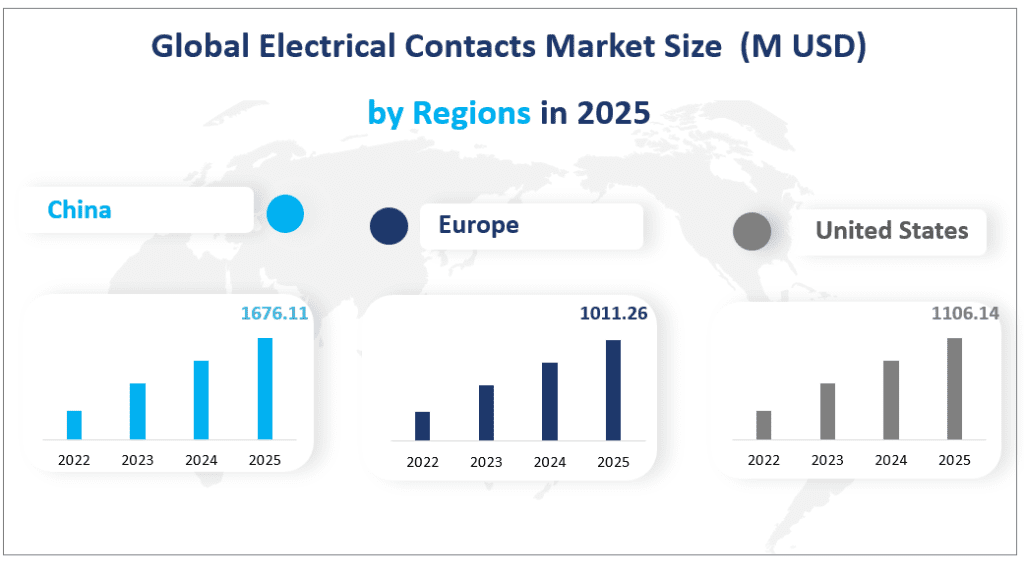1. Global Electrical Contacts Market Overview
By 2025, the global Electrical Contacts market revenue is projected to reach $5803.65 million with a CAGR of 4.86% from 2025 to 2030.
Electrical contacts are essential components in various electrical devices, including switches, relays, connectors, and circuit breakers. These contacts are typically made from electrically conductive materials, such as metals, and are designed to pass electrical current with minimal resistance. They are crucial for ensuring the reliability and efficiency of electrical systems across multiple industries.
Electrical contacts can be categorized into three main types: low-voltage, medium and high-voltage, and light load contacts. Low-voltage contacts are used in applications with voltages up to 50 volts, making them suitable for household and small-scale commercial uses. Medium and high-voltage contacts are designed for more demanding applications, such as power grids and industrial machinery, where voltages can range from 1 to 35 kV or higher. Light load contacts, on the other hand, are used in situations where the electrical load is relatively low compared to the full capacity of the system.
Global Electrical Contacts Market Revenue (M USD) in 2025


2. Driving Factors of Electrical Contacts Market
The growth of the global Electrical Contacts market is influenced by several key factors. On the positive side, the increasing demand from downstream industries is a major driver. As the global economy develops and the population grows, the need for reliable and efficient electrical systems is becoming more critical. This is particularly evident in the automotive and aerospace sectors, where the adoption of electric vehicles and advanced avionics is driving the demand for high-quality electrical contacts.
Another significant driver is the ongoing technological innovation in the electrical contacts industry. Companies are continuously investing in research and development to improve the performance and durability of their products. For example, the development of new materials and manufacturing processes is enabling the production of contacts with higher conductivity, lower resistance, and better resistance to wear and corrosion. These advancements are not only enhancing the performance of electrical systems but also expanding the potential applications for electrical contacts.
3. Limiting Factors of Electrical Contacts Market
However, the market also faces several limiting factors. One of the main challenges is the high technical barriers and complex manufacturing processes involved in producing electrical contacts. This industry requires significant investment in specialized equipment and skilled labor, which can be a barrier for new entrants. Additionally, the market is highly competitive, with a few dominant players controlling a large share of the market. This makes it difficult for smaller companies to gain a foothold and compete effectively.
Environmental regulations are another limiting factor. The production of electrical contacts involves the use of metals such as silver and copper, which can have environmental impacts if not managed properly. Companies must invest in advanced waste treatment and recycling technologies to minimize their environmental footprint. This adds to the cost of production and can limit the growth of the market.
4. Electrical Contacts Market Segment
Product Types
Low-Voltage Electrical Contacts: This segment is expected to generate a revenue of $4672.33 million in 2025. Low-voltage contacts are designed for applications with voltages up to 50 volts and are widely used in household appliances, small-scale industrial equipment, and consumer electronics. Their versatility and broad application base make them a significant contributor to the market revenue.
Medium and High Voltage Electrical Contacts: This segment is projected to have a revenue of $578.22 million in 2025. These contacts are used in high-power applications such as power grids, industrial machinery, and heavy electrical equipment. Despite their specialized use, they play a crucial role in the overall market due to their necessity in large-scale electrical systems.
Light Load Electrical Contacts: This segment is expected to contribute $553.10 million to the market revenue in 2025. Light load contacts are designed for applications where the electrical load is relatively low compared to the full capacity of the system. They are commonly used in precision instruments, medical devices, and other low-power applications.
Low-voltage electrical Contacts hold the largest market share, accounting for approximately 80.51% of the total market revenue in 2025. Their widespread use in various industries and applications ensures a consistent demand, making them the dominant segment.
Medium and High Voltage Electrical Contacts have a market share of 9.96% in 2025. While their share is smaller compared to low-voltage contacts, their growth rate is significant, driven by the increasing demand for high-power electrical systems in the industrial and power generation sectors.
Light Load Electrical Contacts have a market share of 9.53% in 2025. Their growth rate is also notable, driven by the increasing demand for precision and low-power applications in sectors such as medical devices and electronics.
Different Applications
Relays: This application is projected to generate a revenue of $2431.36 million in 2025. Relays are used in a wide range of applications, including automotive, industrial control systems, and consumer electronics, making them a significant contributor to the market revenue.
Breaker: This segment is expected to contribute $1187.66 million to the market revenue in 2025. Circuit breakers are essential components in electrical systems, providing overcurrent protection and ensuring safety in various applications.
Contacts: This application is projected to have a revenue of $1252.83 million in 2025. Contacts are used in various electrical devices, including switches, connectors, and control systems, contributing significantly to the overall market revenue.
Industrial Controls: This segment is expected to contribute $615.49 million to the market revenue in 2025. Industrial controls are used in manufacturing, automation, and other industrial applications, driving the demand for high-quality electrical contacts.
Relays hold the largest market share, accounting for approximately 41.89% of the total market revenue in 2025. Their widespread use in various industries ensures a consistent demand, making them the dominant application segment.
Breaker has a market share of 20.46% in 2025. The growth of this segment is driven by the increasing demand for overcurrent protection devices in electrical systems.
Contacts have a market share of 21.59% in 2025. Their growth rate is significant, driven by the increasing demand for high-quality contacts in various electrical devices.
Industrial Controls have a market share of 10.61% in 2025. The growth of this segment is driven by the increasing adoption of automation and advanced manufacturing technologies.
Market Revenue and Share by Segment
| Revenue (M USD) in 2025 | Market Share in 2025 | ||
| By Type | Low-Voltage Electrical Contacts | 4672.33 | 80.51% |
| Medium and High Voltage Electrical Contacts | 578.22 | 9.96% | |
| Light Load Electrical Contacts | 553.10 | 9.53% | |
| By Application | Relays | 2431.36 | 41.89% |
| Breaker | 1187.66 | 20.46% | |
| Contacts | 1252.83 | 21.59% | |
| Industrial Controls | 615.49 | 10.61% |
5. Regional Electrical Contacts Market
The Asia-Pacific region, led by China and Japan, is the largest market for electrical contacts. This dominance is largely due to China’s significant manufacturing capabilities and expanding domestic demand with a market value of $1676.11 million in 2025, coupled with Japan’s advanced technological advancements. The region’s rapid industrialization, technological advancements, and increasing demand from downstream industries such as automotive, electronics, and power generation are driving significant growth. China alone accounts for a substantial portion of the regional market, with its strong manufacturing base and expanding domestic demand.
Europe’s market is driven by its advanced manufacturing capabilities with a market size of $1011.26 million in 2025, particularly in Germany, France, and the UK. The region benefits from a strong presence of global players and a focus on high-quality, technologically advanced products. The demand for electrical contacts in the automotive, aerospace, and industrial control sectors is a significant growth driver.
North America, particularly the United States with a market size of $1106.14 million in 2025, is a major market for electrical contacts, driven by the automotive, aerospace, and electronics industries. The region’s focus on innovation and high-tech applications ensures a consistent demand for advanced electrical contacts.
The Middle East and Africa region is driven by increasing demand from the power generation and industrial sectors. Countries like Saudi Arabia and the UAE are investing heavily in infrastructure and renewable energy projects, driving the demand for electrical contacts.
Central and South America is the fastest-growing region. This rapid growth is driven by ongoing industrialization, infrastructure development, and increasing demand from key sectors such as automotive and manufacturing.
Global Electrical Contacts Market Size (M USD) by Regions in 2025


6. Top 3 Companies in the Electrical Contacts Market
Company Introduction and Business Overview: Tanaka is a leading global player in the electrical contacts market, with a strong presence in Japan and China. Established in 1885, the company specializes in the production of high-quality electrical contacts and related products. Tanaka’s business scope includes precious metals and industrial materials, with a focus on innovation and technological advancement.
Products Offered: Tanaka offers a wide range of electrical contacts, including low-voltage, medium and high-voltage, and light load contacts. Their products are used in various applications, such as relays, circuit breakers, and industrial controls. Tanaka is known for its high-quality materials and advanced manufacturing processes.
Company Introduction and Business Overview: Longsun is a prominent player in the electrical contacts market, with a strong manufacturing base in China. Established in 1986, the company specializes in the production of electrical contact materials and components. Longsun is known for its innovative products and strong market presence in both domestic and international markets.
Products Offered: Longsun offers a variety of electrical contacts, including rivet contacts, composite contacts, and button contacts. Their products are used in applications such as relays, breakers, and industrial controls. Longsun’s focus on research and development ensures that their products meet the highest standards of quality and performance.
Company Introduction and Business Overview: Fuda is a leading manufacturer of electrical contacts, with a strong presence in China. Established in 1999, the company specializes in the production of alloy contact materials and related products. Fuda is known for its high-quality products and strong market position in both domestic and international markets.
Products Offered: Fuda offers a wide range of electrical contacts, including low-voltage, medium and high-voltage, and light-load contacts. Their products are used in various applications, such as relays, circuit breakers, and industrial controls. Fuda’s focus on innovation and quality ensures that its products meet the highest standards.
Major Players
| Company Name | Plants Distribution | Sales Region |
| Tanaka | In Japan, China | Worldwide |
| Longsun | In China | Worldwide |
| Fuda | In China | Worldwide |
| Umicore | In Germany, US | Worldwide |
| Wenzhou Hongfeng | In China | Mainly in North America, Asia, Europe |
| DODUCO | In Germany, Spain, Romania, and China | Mainly in Europe, Asia |
| Chugai Electric | In Japan, Malaysia, China | Mainly in Asia, North America |
| Guilin Coninst | In China | Mainly in Asia, Europe, US |
| Brainin | In U.S., Mexico, Dominican Republic, China | Worldwide |
| Nippon Tungsten | In Japan | Mainly in North America, Europe |
| MATERION | In US | Mainly in North America, Europe |
| Foshan Tongbao | In China | Worldwide |
| Anping Feichang | In China | Mainly in Asia |
1 Electrical Contacts Market Overview
1.1 Product Overview and Scope of Electrical Contacts
1.2 Electrical Contacts Segment by Type
1.2.1 Global Electrical Contacts Production and CAGR (%) Comparison by Type (2015-2027)
1.2.2 The Market Profile of Low-Voltage Electrical Contacts
1.2.3 The Market Profile of Medium and High Voltage Electrical Contacts
1.2.4 The Market Profile of Light Load Electrical Contacts
1.3 Global Electrical Contacts Segment by Application
1.3.1 Electrical Contacts Consumption (Sales) Comparison by Application (2015-2027)
1.3.2 The Market Profile of Relays
1.3.3 The Market Profile of Breaker
1.3.4 The Market Profile of Contacts
1.3.5 The Market Profile of Industrial Controls
1.4 Global Electrical Contacts Market by Region (2015-2027)
1.4.1 Global Electrical Contacts Market Size (Value) and CAGR (%) Comparison by Region (2015-2027)
1.4.2 United States Electrical Contacts Market Status and Prospect (2015-2027)
1.4.3 Europe Electrical Contacts Market Status and Prospect (2015-2027)
1.4.4 China Electrical Contacts Market Status and Prospect (2015-2027)
1.4.5 Japan Electrical Contacts Market Status and Prospect (2015-2027)
1.4.6 India Electrical Contacts Market Status and Prospect (2015-2027)
1.4.7 Southeast Asia Electrical Contacts Market Status and Prospect (2015-2027)
1.4.8 Central and South America Electrical Contacts Market Status and Prospect (2015-2027)
1.4.9 Middle East and Africa Electrical Contacts Market Status and Prospect (2015-2027)
1.5 Global Market Size (Value) of Electrical Contacts (2015-2027)
1.5.1 Global Electrical Contacts Revenue Status and Outlook (2015-2027)
1.5.2 Global Electrical Contacts Production Status and Outlook (2015-2027)
2 Global Electrical Contacts Market Landscape by Player
2.1 Global Electrical Contacts Production and Share by Player (2015-2020)
2.2 Global Electrical Contacts Revenue and Market Share by Player (2015-2020)
2.3 Global Electrical Contacts Average Price by Player (2015-2020)
2.4 Electrical Contacts Manufacturing Base Distribution, Sales Area and Product Type by Player
2.5 Electrical Contacts Market Competitive Situation and Trends
2.5.1 Electrical Contacts Market Concentration Rate
2.5.2 Electrical Contacts Market Share of Top 3 and Top 6 Players
2.5.3 Mergers & Acquisitions, Expansion
3 Players Profiles
3.1 Tanaka
3.1.1 Tanaka Basic Information, Manufacturing Base, Sales Area and Competitors
3.1.2 Electrical Contacts Product Profiles, Application and Specification
3.1.3 Tanaka Electrical Contacts Market Performance (2015-2020)
3.1.4 Tanaka Business Overview
3.2 Longsun
3.2.1 Longsun Basic Information, Manufacturing Base, Sales Area and Competitors
3.2.2 Electrical Contacts Product Profiles, Application and Specification
3.2.3 Longsun Electrical Contacts Market Performance (2015-2020)
3.2.4 Longsun Business Overview
3.3 Fuda
3.3.1 Fuda Basic Information, Manufacturing Base, Sales Area and Competitors
3.3.2 Electrical Contacts Product Profiles, Application and Specification
3.3.3 Fuda Electrical Contacts Market Performance (2015-2020)
3.3.4 Fuda Business Overview
3.4 Umicore
3.4.1 Umicore Basic Information, Manufacturing Base, Sales Area and Competitors
3.4.2 Electrical Contacts Product Profiles, Application and Specification
3.4.3 Umicore Electrical Contacts Market Performance (2015-2020)
3.4.4 Umicore Business Overview
3.5 Wenzhou Hongfeng
3.5.1 Wenzhou Hongfeng Basic Information, Manufacturing Base, Sales Area and Competitors
3.5.2 Electrical Contacts Product Profiles, Application and Specification
3.5.3 Wenzhou Hongfeng Electrical Contacts Market Performance (2015-2020)
3.5.4 Wenzhou Hongfeng Business Overview
3.6 DODUCO
3.6.1 DODUCO Basic Information, Manufacturing Base, Sales Area and Competitors
3.6.2 Electrical Contacts Product Profiles, Application and Specification
3.6.3 DODUCO Electrical Contacts Market Performance (2015-2020)
3.6.4 DODUCO Business Overview
3.7 Chugai Electric
3.7.1 Chugai Electric Basic Information, Manufacturing Base, Sales Area and Competitors
3.7.2 Electrical Contacts Product Profiles, Application and Specification
3.7.3 Chugai Electric Electrical Contacts Market Performance (2015-2020)
3.7.4 Chugai Electric Business Overview
3.8 Guilin Coninst
3.8.1 Guilin Coninst Basic Information, Manufacturing Base, Sales Area and Competitors
3.8.2 Electrical Contacts Product Profiles, Application and Specification
3.8.3 Guilin Coninst Electrical Contacts Market Performance (2015-2020)
3.8.4 Guilin Coninst Business Overview
3.9 Brainin
3.9.1 Brainin Basic Information, Manufacturing Base, Sales Area and Competitors
3.9.2 Electrical Contacts Product Profiles, Application and Specification
3.9.3 Brainin Electrical Contacts Market Performance (2015-2020)
3.9.4 Brainin Business Overview
3.10 Nippon Tungsten
3.10.1 Nippon Tungsten Basic Information, Manufacturing Base, Sales Area and Competitors
3.10.2 Electrical Contacts Product Profiles, Application and Specification
3.10.3 Nippon Tungsten Electrical Contacts Market Performance (2015-2020)
3.10.4 Nippon Tungsten Business Overview
3.11 MATERION
3.11.1 MATERION Basic Information, Manufacturing Base, Sales Area and Competitors
3.11.2 Electrical Contacts Product Profiles, Application and Specification
3.11.3 MATERION Electrical Contacts Market Performance (2015-2020)
3.11.4 MATERION Business Overview
3.12 Foshan Tongbao
3.12.1 Foshan Tongbao Basic Information, Manufacturing Base, Sales Area and Competitors
3.12.2 Electrical Contacts Product Profiles, Application and Specification
3.12.3 Foshan Tongbao Electrical Contacts Market Performance (2015-2020)
3.12.4 Foshan Tongbao Business Overview
3.13 Anping Feichang
3.13.1 Anping Feichang Basic Information, Manufacturing Base, Sales Area and Competitors
3.13.2 Electrical Contacts Product Profiles, Application and Specification
3.13.3 Anping Feichang Electrical Contacts Market Performance (2015-2020)
3.13.4 Anping Feichang Business Overview
4 Global Electrical Contacts Production, Revenue (Value), Price Trend by Type
4.1 Global Electrical Contacts Production and Market Share by Type (2015-2020)
4.2 Global Electrical Contacts Revenue and Market Share by Type (2015-2020)
4.3 Global Electrical Contacts Price by Type (2015-2020)
4.4 Global Electrical Contacts Production Growth Rate by Type (2015-2020)
4.4.1 Global Electrical Contacts Production Growth Rate of Low-Voltage Electrical Contacts (2015-2020)
4.4.2 Global Electrical Contacts Production Growth Rate of Medium and High Voltage Electrical Contacts (2015-2020)
4.4.3 Global Electrical Contacts Production Growth Rate of Light Load Electrical Contacts (2015-2020)
5 Global Electrical Contacts Market Analysis by Application
5.1 Global Electrical Contacts Consumption and Market Share by Application (2015-2020)
5.2 Global Electrical Contacts Consumption Growth Rate by Application (2015-2020)
5.2.1 Global Electrical Contacts Consumption Growth Rate of Relays (2015-2020)
5.2.2 Global Electrical Contacts Consumption Growth Rate of Breaker (2015-2020)
5.2.3 Global Electrical Contacts Consumption Growth Rate of Contacts (2015-2020)
5.2.4 Global Electrical Contacts Consumption Growth Rate of Industrial Controls (2015-2020)
6 Global Electrical Contacts Production, Consumption, Export, Import by Region (2015-2020)
6.1 Global Electrical Contacts Consumption by Region (2015-2020)
6.2 United States Electrical Contacts Production, Consumption, Export, Import (2015-2020)
6.2.1 United States Electrical Contacts Market Under COVID-19
6.3 Europe Electrical Contacts Production, Consumption, Export, Import (2015-2020)
6.3.1 Europe Electrical Contacts Market Under COVID-19
6.4 China Electrical Contacts Production, Consumption, Export, Import (2015-2020)
6.4.1 China Electrical Contacts Market Under COVID-19
6.5 Japan Electrical Contacts Production, Consumption, Export, Import (2015-2020)
6.5.1 Japan Electrical Contacts Market Under COVID-19
6.6 India Electrical Contacts Production, Consumption, Export, Import (2015-2020)
6.6.1 India Electrical Contacts Market Under COVID-19
6.7 Southeast Asia Electrical Contacts Production, Consumption, Export, Import (2015-2020)
6.7.1 Southeast Asia Electrical Contacts Market Under COVID-19
6.8 Central and South America Electrical Contacts Production, Consumption, Export, Import (2015-2020)
6.8.1 Central and South America Electrical Contacts Market Under COVID-19
6.9 Middle East and Africa Electrical Contacts Production, Consumption, Export, Import (2015-2020)
6.9.1 Middle East and Africa Electrical Contacts Market Under COVID-19
7 Global Electrical Contacts Production, Revenue (Value) by Region (2015-2020)
7.1 Global Electrical Contacts Production and Market Share by Region (2015-2020)
7.2 Global Electrical Contacts Revenue (Value) and Market Share by Region (2015-2020)
7.3 Global Electrical Contacts Production, Revenue, Price and Gross Margin (2015-2020)
7.4 United States Electrical Contacts Production, Revenue, Price and Gross Margin (2015-2020)
7.5 Europe Electrical Contacts Production, Revenue, Price and Gross Margin (2015-2020)
7.6 China Electrical Contacts Production, Revenue, Price and Gross Margin (2015-2020)
7.7 Japan Electrical Contacts Production, Revenue, Price and Gross Margin (2015-2020)
7.8 India Electrical Contacts Production, Revenue, Price and Gross Margin (2015-2020)
7.9 Southeast Asia Electrical Contacts Production, Revenue, Price and Gross Margin (2015-2020)
7.10 Central and South America Electrical Contacts Production, Revenue, Price and Gross Margin (2015-2020)
7.11 Middle East and Africa Electrical Contacts Production, Revenue, Price and Gross Margin (2015-2020)
8 Electrical Contacts Manufacturing Analysis
8.1 Electrical Contacts Key Raw Materials Analysis
8.1.1 Key Raw Materials Introduction
8.1.2 Price Trend of Key Raw Materials
8.1.3 Key Suppliers of Raw Materials
8.2 Manufacturing Cost Analysis
8.2.1 Labor Cost Analysis
8.2.2 Manufacturing Cost Structure Analysis
8.3 Manufacturing Process Analysis of Electrical Contacts
9 Industrial Chain, Sourcing Strategy and Downstream Buyers
9.1 Electrical Contacts Industrial Chain Analysis
9.2 Raw Materials Sources of Electrical Contacts Major Players in 2020
9.3 Downstream Buyers
9.4 Value Chain Status Under COVID-19
10 Market Dynamics
10.1 Drivers
10.2 Restraints
10.3 Opportunities
10.3.1 Upstream Supply
10.3.2 Manufacturer
10.3.3 Sales Channels
10.3.4 Downstream
10.4 Challenges
10.5 Porter’s Five Forces Analysis
10.5.1 Threat of New Entrants
10.5.2 Threat of Substitutes
10.5.3 Bargaining Power of Suppliers
10.5.4 Bargaining Power of Buyers
10.5.5 Intensity of Competitive Rivalry
10.6 Electrical Contacts Industry Development Trends under COVID-19 Outbreak
10.6.1 Global COVID-19 Status Overview
10.6.2 Influence of COVID-19 Outbreak on Electrical Contacts Industry Development
11 Global Electrical Contacts Market Forecast (2020-2027)
11.1 Global Electrical Contacts Production, Revenue Forecast (2020-2027)
11.1.1 Global Electrical Contacts Production and Growth Rate Forecast (2020-2027)
11.1.2 Global Electrical Contacts Revenue and Growth Rate Forecast (2020-2027)
11.1.3 Global Electrical Contacts Price and Trend Forecast (2020-2027)
11.2 Global Electrical Contacts Production, Consumption, Export and Import Forecast by Region (2020-2027)
11.2.1 United States Electrical Contacts Production, Consumption, Export and Import Forecast (2020-2027)
11.2.2 Europe Electrical Contacts Production, Consumption, Export and Import Forecast (2020-2027)
11.2.3 China Electrical Contacts Production, Consumption, Export and Import Forecast (2020-2027)
11.2.4 Japan Electrical Contacts Production, Consumption, Export and Import Forecast (2020-2027)
11.2.5 India Electrical Contacts Production, Consumption, Export and Import Forecast (2020-2027)
11.2.6 Southeast Asia Electrical Contacts Production, Consumption, Export and Import Forecast (2020-2027)
11.2.7 Central and South America Electrical Contacts Production, Consumption, Export and Import Forecast (2020-2027)
11.2.8 Middle East and Africa Electrical Contacts Production, Consumption, Export and Import Forecast (2020-2027)
11.3 Global Electrical Contacts Production, Revenue and Price Forecast by Type (2020-2027)
11.4 Global Electrical Contacts Consumption Forecast by Application (2020-2027)
11.5 Electrical Contacts Market Forecast Under COVID-19
12 Research Findings and Conclusion
13 Appendix
13.1 Methodology
13.2 Research Data Source
